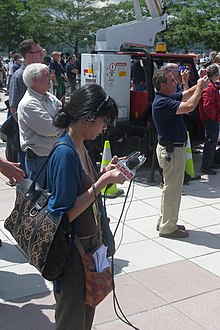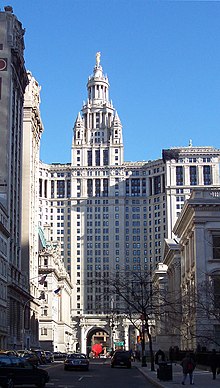WNYC (AM)
[12] WNYC was now licensed on 810 kHz with unlimited daytime hours, but, unless it received special permission, was restricted from making nighttime broadcasts.
WNYC's transmitter was moved in 1937 from the Municipal Building to city-owned land at 10 Kent Street in Greenpoint, Brooklyn, as part of a Works Progress Administration (WPA) project.
Now, under an agency devoted singularly to its function and with the leadership of new director Morris S. Novik, appointed by Mayor LaGuardia, WNYC became a model public broadcaster.
Beginning during World War II, the FCC allowed WNYC to stay on the air a few extra hours in the evening due to the public service it was providing.
In 1990, as a result of continued interference with WCCO, and a court ruling in WCCO's favor rescinding the WWII-era approval for nighttime operation by WNYC,[14] the station moved from 830 kHz to 820 kHz, commenced around-the-clock operations and increased its daytime power to 10,000 watts, while maintaining 1,000 watts at night, to protect WBAP in Fort Worth, Texas; WBAP is also a primary clear-channel assignment, but is farther from New York City than Minneapolis.
As part of a crackdown on prostitution in 1979, then-Mayor Ed Koch tried to use the three WNYC radio and television stations to broadcast the names of "johns" arrested for soliciting.
Announcers threatened a walkout over what was casually called the John Hour and station management refused to comply with the idea; after one forced broadcast with city employees reading off the names, it was discontinued.
Giuliani believed that broadcasting was no longer essential as a municipal service, and that the financial compensation from selling the stations could be used to help the City cover budget shortfalls.
WNYC's studios, in the nearby Manhattan Municipal Building, had to be evacuated and station staff was unable to return to its offices for three weeks.
WNYC temporarily moved to studios at National Public Radio's New York bureau in midtown Manhattan, where it broadcast on its still-operating AM signal transmitting from towers in Kearny, New Jersey, and on a live Internet stream.
On June 16, 2008, WNYC moved from its 51,400 square feet (4,780 m2) of rent-free space scattered on eight floors of the Manhattan Municipal Building to a new location at 160 Varick Street, near the Holland Tunnel.
There is a 140-seat, street-level studio for live broadcasts, concerts and public forums, named The Jerome L. Greene Performance Space, and an expansion of the newsroom to over 60 journalists.
Following the U.S. entry into World War II, then-mayor Fiorello H. La Guardia made use of the station every Sunday in his Talk to the People program.
During a 17-day newspaper workers' strike, La Guardia also used the WNYC airwaves to read the latest comic strips to local youngsters while they were not available in New York.


